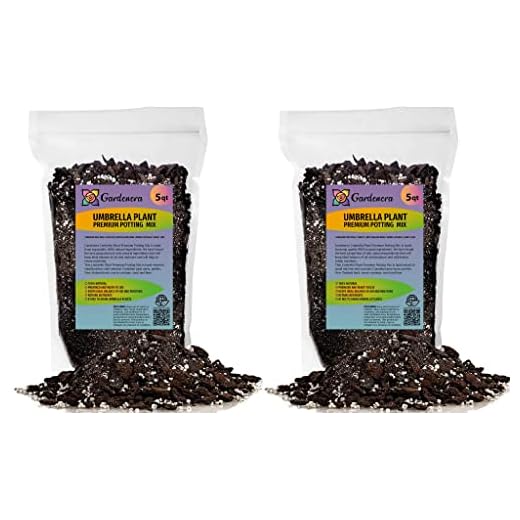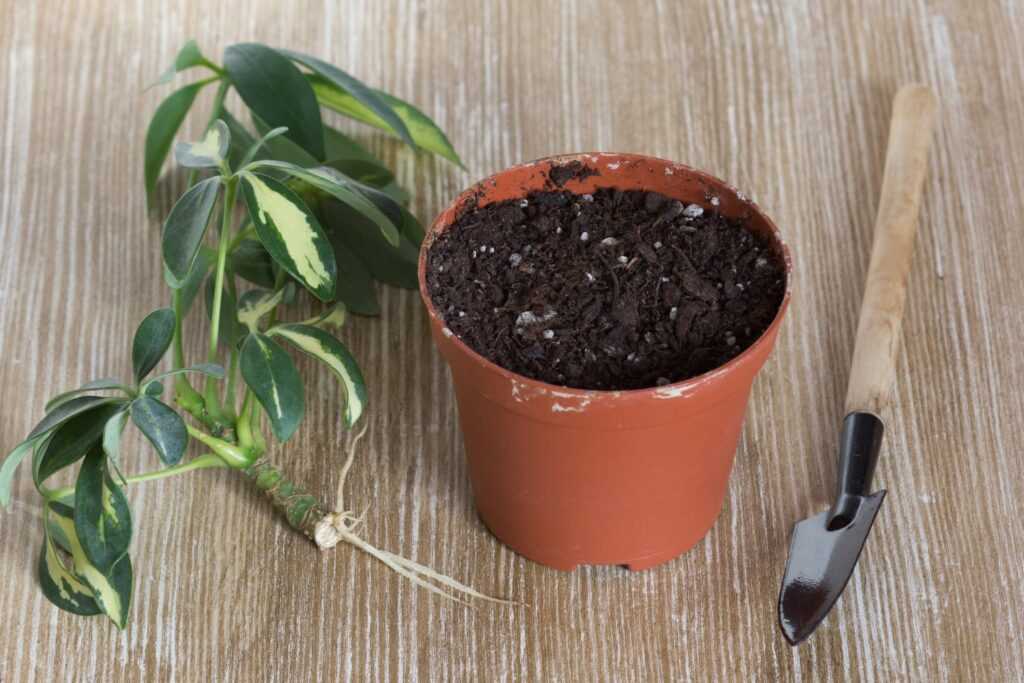




For optimal growth of your Schefflera, a blend that promotes aeration and moisture retention is key. Look for a mixture containing peat moss, perlite, and bark. This combination ensures that the roots receive sufficient air while also retaining enough moisture for healthy development.
This article is tailored for both novice and experienced gardeners seeking to enhance their indoor green space. You will find specific recommendations for various growing conditions and tips to maintain the ideal environment for your Schefflera.
We’ll discuss the importance of drainage, the role of organic materials, and the pH levels that favor your plant’s growth. Additionally, practical advice on repotting and care routines will be provided. By the end, you will be equipped with the knowledge to select and prepare the best growing medium for your Schefflera, ensuring it thrives in your home.
Best Soil Mix for Schefflera
The ideal growing medium for Schefflera requires a blend that promotes excellent drainage while retaining enough moisture. A combination of peat moss, perlite, and pine bark works effectively. This mix ensures that the roots receive adequate aeration and prevents waterlogging, which can lead to root rot.
Consider the pH level of the mixture, which should typically range from 6.0 to 7.0. This range supports healthy nutrient uptake. Adding a slow-release fertilizer can further enhance growth, providing essential nutrients over time.
Characteristics of an Ideal Mix
- Drainage: Ensure the mixture allows excess water to flow freely.
- Moisture Retention: Incorporate materials that help maintain moisture without becoming overly saturated.
- Nutrient Content: Use organic matter to enrich the blend with necessary nutrients.
- pH Balance: Aim for a neutral to slightly acidic pH for optimal growth.
To create a custom blend, combine the following ratios:
- 50% peat moss or coconut coir
- 30% perlite or coarse sand
- 20% pine bark or compost
Regularly monitor the moisture levels in the container and adjust watering based on the plant’s needs. This tailored approach can significantly enhance the health and vitality of your Schefflera.
Understanding the Umbrella Plant’s Soil Needs
The ideal growing medium for this tropical species must provide excellent drainage while retaining adequate moisture. A mix that allows air circulation is necessary to promote healthy root development. Using components such as peat moss, perlite, and pine bark can create a balanced environment for growth.
This species thrives in slightly acidic to neutral pH levels, typically ranging from 6.0 to 7.0. Regular testing of the medium’s pH can help maintain optimal conditions for nutrient uptake. Adjustments can be made using amendments like sulfur to lower pH or lime to increase it.
Key Components for Growth
- Drainage: Ensure the mix has sufficient aeration to prevent root rot.
- Moisture Retention: Include materials that hold water without becoming waterlogged.
- Nutrient Content: Incorporate organic matter to provide essential nutrients.
Regular monitoring of moisture levels will help gauge when to water. The medium should dry out slightly between watering sessions to prevent excess moisture, which can lead to fungal issues. Proper drainage holes in pots are also necessary to allow excess water to escape.
By focusing on these characteristics, the growing environment will support the health and growth of the umbrella species, leading to a lush and thriving appearance.
Key Ingredients for Optimal Growth Medium
For a thriving indoor greenery, specific components are critical in the growth medium. A blend that combines moisture retention, aeration, and nutrient availability is essential for robust development.
Organic matter, such as peat moss or coconut coir, serves as a foundation. These materials help retain moisture while allowing air circulation, preventing root rot. Additionally, incorporating perlite or vermiculite enhances drainage, ensuring that excess water does not accumulate.
Nutrient-Rich Additives
To support healthy growth, integrating fertilizers into the mixture can provide necessary nutrients. Slow-release granules or organic compost can enrich the medium over time.
- Peat Moss: Improves moisture retention and provides a stable pH level.
- Coconut Coir: An eco-friendly alternative that enhances aeration.
- Perlite: Lightweight volcanic glass that improves drainage.
- Vermiculite: Helps with moisture retention and aeration.
- Compost: A source of essential nutrients and beneficial microorganisms.
Combining these elements creates a balanced environment for root development and overall plant health. Regular monitoring and adjustments will further enhance growth potential.
Recommended Soil Brands for Umbrella Plants
Choosing the right medium is key to the health of your green companion. Certain brands offer specialized mixtures that support the growth of these indoor specimens, ensuring they thrive indoors.
Look for blends that provide excellent drainage and aeration, as these characteristics are crucial for optimal root development. A mix that includes peat moss and perlite can enhance moisture retention while preventing waterlogging.
Considerations for Selection
When selecting a mixture, pay attention to the following:
- Drainage: Proper drainage is essential to avoid root rot. Look for mixes that incorporate materials like perlite or sand.
- Nutrient Content: A balanced nutrient profile helps support growth. Organic components can enrich the mix.
- pH Level: Aim for a slightly acidic to neutral pH, ideally between 6.0 and 7.0, to promote healthy growth.
Brands that focus on organic ingredients often provide a richer environment for your greenery. It’s beneficial to choose those that emphasize sustainability and environmentally friendly practices.
In summary, prioritize mixtures that promote healthy drainage, nutrient availability, and optimal pH levels. This will ensure your leafy friend flourishes in its new home.
How to Create Your Own Potting Mix
Combining various components can lead to a customized blend that meets the specific needs of your greenery. Begin with a base of organic material that ensures good drainage and aeration.
Mix equal parts of peat moss and perlite or vermiculite. This combination allows for moisture retention while preventing compaction. Additionally, incorporating compost enhances nutrient availability, promoting healthy growth.
Ingredients for Your Custom Blend
- Peat Moss: Provides moisture retention and acidity.
- Perlite: Aids in aeration and drainage.
- Vermiculite: Retains moisture and nutrients.
- Compost: Adds essential nutrients and improves soil structure.
- Sand: Increases drainage if necessary.
Mix these ingredients thoroughly, adjusting ratios based on the type of greenery being potted. For instance, more perlite may be beneficial for plants that prefer drier conditions, while more compost is suitable for those needing extra nutrients.
Testing the pH of your mixture can also be beneficial. Many plants thrive in slightly acidic to neutral conditions, so adjust with lime or sulfur as needed. Store any excess blend in a dry, airtight container for future use.
Signs of Poor Soil Quality in Umbrella Plants
Recognizing inadequate growing medium conditions is vital for maintaining the health of your greenery. A few clear indicators can help you identify issues before they escalate.
One of the primary signs is the appearance of wilting leaves, despite adequate watering. This often indicates problems with drainage or compaction, preventing roots from accessing necessary moisture and nutrients. Additionally, yellowing foliage can signify nutrient deficiencies or poor aeration.
Common Indicators
- Wilting Leaves: Leaves droop even after watering.
- Yellowing Foliage: Leaves turn yellow due to nutrient issues.
- Slow Growth: Stunted development could indicate a lack of essential elements.
- Unpleasant Odor: A foul smell might suggest anaerobic conditions.
- Pests: Increased pest activity can signal an unhealthy environment.
Monitoring these signs regularly can help you maintain optimal conditions for your greenery. Addressing issues promptly will ensure your green companion thrives.
Maintenance Tips for Healthy Growing Medium
Regular aeration is key to maintaining a thriving environment for your greenery. Gently mixing the top layer of the medium every few weeks prevents compaction and promotes even moisture distribution. This practice also helps to prevent mold growth and allows for better root development.
Monitor moisture levels by sticking your finger about an inch into the medium. If it feels dry, it’s time to water. Ensure that excess water can drain freely by using pots with adequate drainage holes. Overwatering can lead to root rot, which is detrimental to your foliage.
Additional Care Recommendations
- Fertilization: Use a balanced, water-soluble fertilizer every 4-6 weeks during the growing season to provide necessary nutrients.
- pH Testing: Check the pH level periodically; most plants thrive in a slightly acidic to neutral range (6.0 to 7.0).
- Replacement: Refresh the medium every 1-2 years to prevent nutrient depletion and to rejuvenate the structure.
- Pest Control: Regularly inspect for pests. If found, treat with appropriate organic solutions to avoid chemical damage.
Maintaining a healthy growing medium requires consistent care and attention. By aerating, monitoring moisture, and providing nutrients, you can ensure a robust foundation for your greenery, leading to lush and vibrant growth.
Best potting soil for umbrella plant
Features
| Part Number | POTHOS-10QT |
| Model | POTHOS-10QT |
| Color | Pothos Potting Mix |
| Size | 10 Quart Bag |
Features
| Part Number | Mulctun-SP+ZZY-29QT |
| Model | Mulctun-SP+ZZY-29QT |
| Size | 29 qt |
Features
| Part Number | 75652301 |
| Model | 75652301 |
| Color | Multicolor |
| Size | 2 Pack |
Features
| Part Number | MAIN-UMBRELLA-10QT |
| Model | MAIN-UMBRELLA-10QT |
| Color | Umbrella Plant Potting Mix |
| Size | 10 Quart Bag |
Features
| Part Number | MAM-10DQ-US |
| Model | MAM-10DQ-US |
| Color | Brown |
| Size | 10 Dry Quarts |
Features
| Part Number | 15503 |
| Size | 5 Pack |
Features
| Part Number | CC50 |
| Model | Loose50 |
| Size | 50L |
Video:
FAQ:
What type of potting soil is best for an umbrella plant?
The ideal potting soil for an umbrella plant, also known as Schefflera, should be well-draining yet retain some moisture. A mix that includes peat moss, perlite, and pine bark is often recommended. This combination allows for adequate aeration and prevents water from pooling at the roots, which can lead to root rot. It’s also beneficial to choose a soil with a slightly acidic to neutral pH level, typically around 6.0 to 7.0, to support healthy growth.
How do I know if my umbrella plant needs repotting and what soil should I use?
Signs that your umbrella plant needs repotting include roots growing out of the drainage holes, slow growth, or yellowing leaves. If you notice these signs, it’s time to repot. Use a fresh potting mix that is well-draining. A good recipe includes equal parts of potting soil, perlite, and orchid bark. This mix provides the right balance of moisture retention and aeration, ensuring your plant has the best conditions to thrive. Additionally, choose a pot that is 1-2 inches larger in diameter than the current one to allow for growth.










